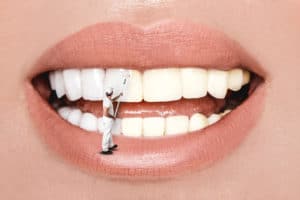When I was a kid, I always wondered if I should floss or brush first! Then I would ask my mom, and the next day, I would forget again! It is almost like when you are trying to make mimosa! Which one goes first? Orange juice or your bubbly? For the longest time, I would forget which ones goes first, and now, I finally seem to have learned it! It is the OJ that goes in first!
Is there even a difference between brushing first or flossing first? According to studies, there is. You will get the best result if you floss first.
Do you even need to floss? Each tooth has 5 surfaces. The chewing surface, the two surfaces facing the adjacent teeth and the last two facing in and out. With a toothbrush, you can clean only three of those 5 surfaces. The surfaces that are facing the adjacent teeth will not be cleaned with a toothbrush. Those are the surfaces that are most likely to get a cavity, because they are not visible and you saliva cannot reach it much to clean it.
Good oral hygiene will not only ensure you will keep you teeth for a long time, but will also make your orthodontic treatment hassle free, pain free and more efficient. Not maintaining good oral health can have some major consequences. Here are some of the most important side effects of not brushing and flossing.
- Making your teeth susceptible to cavities
- White spot formation on your teeth
- Swollen and painful gums
- Bad breath
- Gum disease also known as Periodontal disease
- Bleeding gums
If you see any of the above signs and symptoms, you are most likely not brushing or flossing as much as you are supposed to. But how much is enough? Here are the most important rules about brushing and flossing.
- Rule of thumb is you should brush for 2 minutes after every meal. If you do not have access to a toothbrush, at least rinse your mouth thoroughly.
- Floss at least once a day, preferably before you brush. If you floss just once a day, try to do it at night, before going to bed.
- See your hygienist every 4-6 months. The interval will be determined by your dentist depending on the health of your gums.
- Avoiding frequent intake of sugary food and drinks. Sugary AND carbonated drinks have the worst effect on your teeth.
- The frequency of the intake of sugary food and drinks is much more important than the amount. It is best to finish the consumption of sugary food and drink in one sitting, instead of nibbling on it for a long time.
What tools do I need for brushing?
Here are Dr. Sepi’s favorite tools for brushing. If you have braces, you need some additional tools as well, which will be explained to you once you start your orthodontic treatment.
- A toothbrush. If you are a good brusher, there is no difference between a manual or an electric toothbrush. But if you are not a good brusher, an electric toothbrush might do a better job. Our favorite toothbrush is the Oral-B genius. If you are using a manual toothbrush, try to choose one with a small head. That will help you reach the teeth in the back of your mouth a lot easier.
- Floss or a waterpik. Waterpik does the job of the floss with the pressure of water. If you floss religiously, you do not need a Waterpik. If you are having a hard time committing to flossing, Waterpik might make it a little bit easier for you.
- A Fluoride mouth rinse. Some people might think that using a fluoridated mouth rinse might increase your intake of Fluoride. Rest assured that using a mouth rinse is considered topical use and does not increase your intake of Fluoride.
In order to get a smile you deserve, you should be on board with your orthodontist. Your help is vital in achieving a beautiful smile. Your are your orthodontist’s biggest partner and together you can created a beautiful smile!
